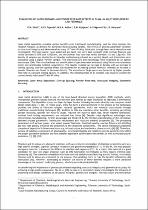 ResearchSpace
ResearchSpace
Evaluation of hatch distance and powder feed rate effects in TI-6AL-4V alloy developed by LMD technique
JavaScript is disabled for your browser. Some features of this site may not work without it.
- ResearchSpace
- →
- Research Publications/Outputs
- →
- Conference Publications
- →
- View Item
| dc.contributor.author |
Sibisi, PN

|
|
| dc.contributor.author |
Popoola, API

|
|
| dc.contributor.author |
Arthur, Nana KK

|
|
| dc.contributor.author |
Kubjane, SM

|
|
| dc.contributor.author |
Ngoveni, AS

|
|
| dc.contributor.author |
Kanyane, LR

|
|
| dc.date.accessioned | 2019-05-14T08:20:01Z | |
| dc.date.available | 2019-05-14T08:20:01Z | |
| dc.date.issued | 2018-11 | |
| dc.identifier.citation | Sibisi, P.N. et al. 2018. Evaluation of hatch distance and powder feed rate effects in TI-6AL-4V alloy developed by LMD technique. The 19th Annual International RAPDASA Conference, Johannesburg, South Africa, 6-9 November 2018 | en_US |
| dc.identifier.isbn | 978-0-620-80987-0 | |
| dc.identifier.uri | https://site.rapdasa.org/wp-content/uploads/2019/03/RAPDASA-2018-Conference-Proceedings-eBook_small.pdf | |
| dc.identifier.uri | http://hdl.handle.net/10204/10994 | |
| dc.description | Paper presented at the 19th Annual International RAPDASA Conference, Johannesburg, South Africa, 6-9 November 2018 | en_US |
| dc.description.abstract | Laser metal deposition provides various benefits over traditional manufacturing, and has since become the research hotspot, as demand for advanced manufacturing persists. The effects of process parameter variation on structural integrity and dimensional accuracy of Ti-6Al-4V alloy fabricated through laser metal deposition was investigated. The laser power, scan speed and gas feed rate were kept constant while overlap distance was varied between 0,3375 and 1,0125mm, and the powder feed rate was varied between 1,6 and 3,8g/min. The density of samples was studied by Archimedes method using ethanol as a wetting liquid, and dimensions were evaluated using a digital Vernier calliper. The microstructure and morphology were examined by an optical microscope (OM). The microhardness and densification of specimen were evaluated using Vickers microhardness tester and Archimedes method, respectively. The results revealed an increase in density with an increase in overlap spacing, and the opposite effect was observed for increasing powder flowrate, whereby an increase in powder flowrate was found to decrease density. The evolution of large pores was favoured by higher powder feed rate at constant overlap spaces. In addition, the microhardness of all samples was found to exceed the conventionally fabricated Ti-6Al-4V alloy. | en_US |
| dc.language.iso | en | en_US |
| dc.publisher | RAPDASA | en_US |
| dc.relation.ispartofseries | Worklist;22330 | |
| dc.subject | Laser metal deposition | en_US |
| dc.subject | Overlap spacing | en_US |
| dc.subject | Powder feed-rate | en_US |
| dc.subject | Structural integrity | en_US |
| dc.subject | Geometric accuracy | en_US |
| dc.title | Evaluation of hatch distance and powder feed rate effects in TI-6AL-4V alloy developed by LMD technique | en_US |
| dc.type | Conference Presentation | en_US |
| dc.identifier.apacitation | Sibisi, P., Popoola, A., Arthur, N. K., Kubjane, S., Ngoveni, A., & Kanyane, L. (2018). Evaluation of hatch distance and powder feed rate effects in TI-6AL-4V alloy developed by LMD technique. RAPDASA. http://hdl.handle.net/10204/10994 | en_ZA |
| dc.identifier.chicagocitation | Sibisi, PN, API Popoola, Nana KK Arthur, SM Kubjane, AS Ngoveni, and LR Kanyane. "Evaluation of hatch distance and powder feed rate effects in TI-6AL-4V alloy developed by LMD technique." (2018): http://hdl.handle.net/10204/10994 | en_ZA |
| dc.identifier.vancouvercitation | Sibisi P, Popoola A, Arthur NK, Kubjane S, Ngoveni A, Kanyane L, Evaluation of hatch distance and powder feed rate effects in TI-6AL-4V alloy developed by LMD technique; RAPDASA; 2018. http://hdl.handle.net/10204/10994 . | en_ZA |
| dc.identifier.ris | TY - Conference Presentation AU - Sibisi, PN AU - Popoola, API AU - Arthur, Nana KK AU - Kubjane, SM AU - Ngoveni, AS AU - Kanyane, LR AB - Laser metal deposition provides various benefits over traditional manufacturing, and has since become the research hotspot, as demand for advanced manufacturing persists. The effects of process parameter variation on structural integrity and dimensional accuracy of Ti-6Al-4V alloy fabricated through laser metal deposition was investigated. The laser power, scan speed and gas feed rate were kept constant while overlap distance was varied between 0,3375 and 1,0125mm, and the powder feed rate was varied between 1,6 and 3,8g/min. The density of samples was studied by Archimedes method using ethanol as a wetting liquid, and dimensions were evaluated using a digital Vernier calliper. The microstructure and morphology were examined by an optical microscope (OM). The microhardness and densification of specimen were evaluated using Vickers microhardness tester and Archimedes method, respectively. The results revealed an increase in density with an increase in overlap spacing, and the opposite effect was observed for increasing powder flowrate, whereby an increase in powder flowrate was found to decrease density. The evolution of large pores was favoured by higher powder feed rate at constant overlap spaces. In addition, the microhardness of all samples was found to exceed the conventionally fabricated Ti-6Al-4V alloy. DA - 2018-11 DB - ResearchSpace DP - CSIR KW - Laser metal deposition KW - Overlap spacing KW - Powder feed-rate KW - Structural integrity KW - Geometric accuracy LK - https://researchspace.csir.co.za PY - 2018 SM - 978-0-620-80987-0 T1 - Evaluation of hatch distance and powder feed rate effects in TI-6AL-4V alloy developed by LMD technique TI - Evaluation of hatch distance and powder feed rate effects in TI-6AL-4V alloy developed by LMD technique UR - http://hdl.handle.net/10204/10994 ER - | en_ZA |





